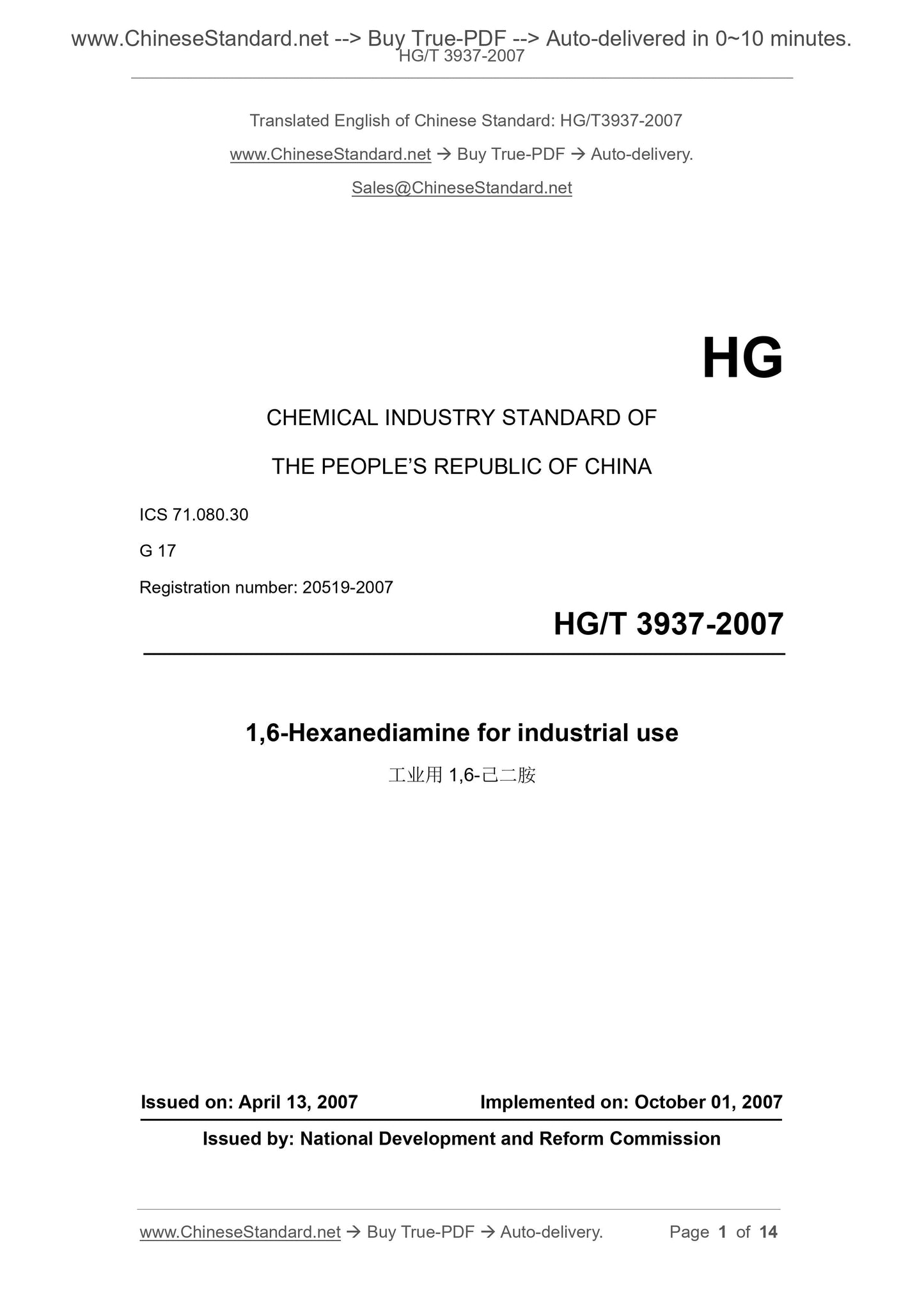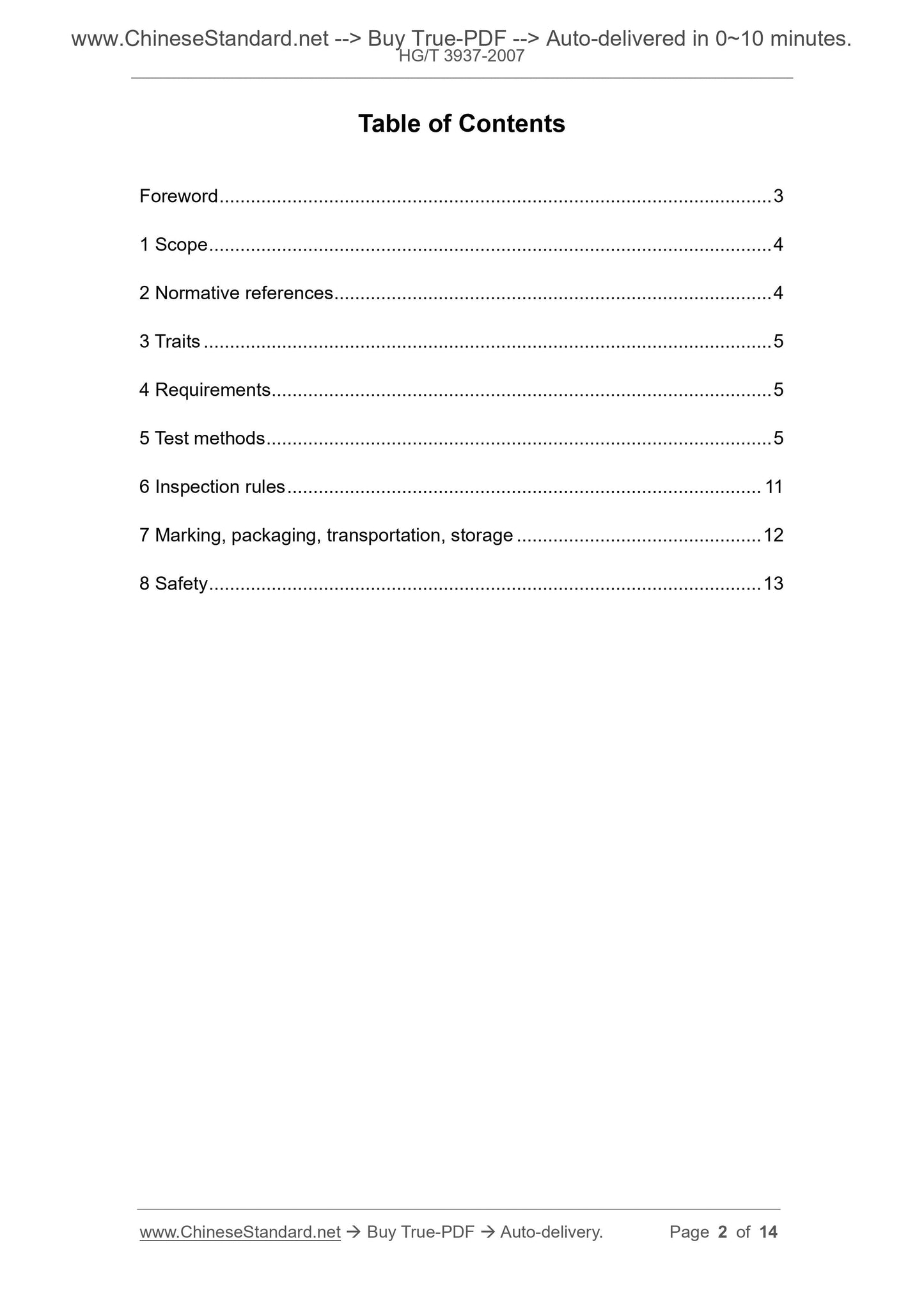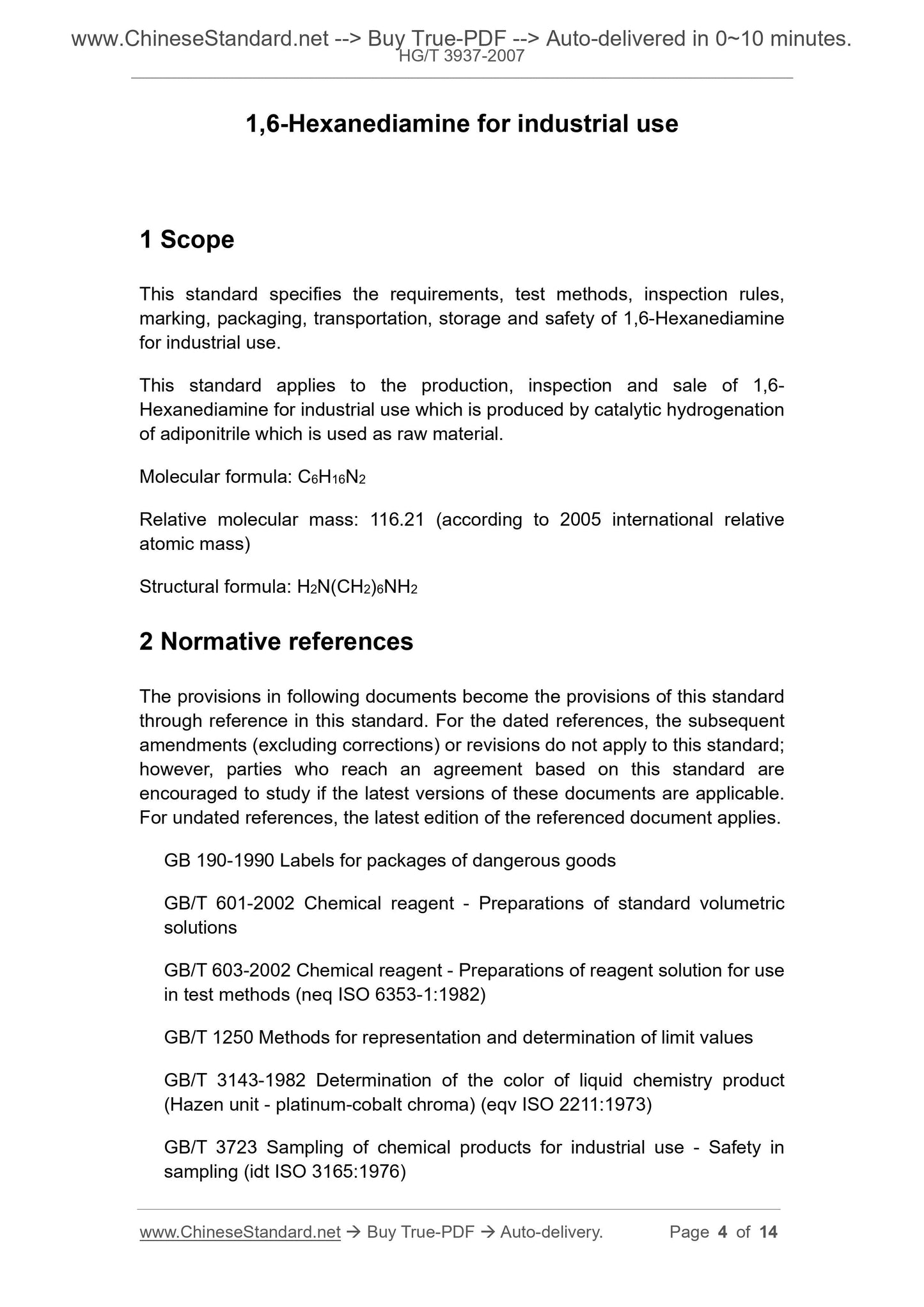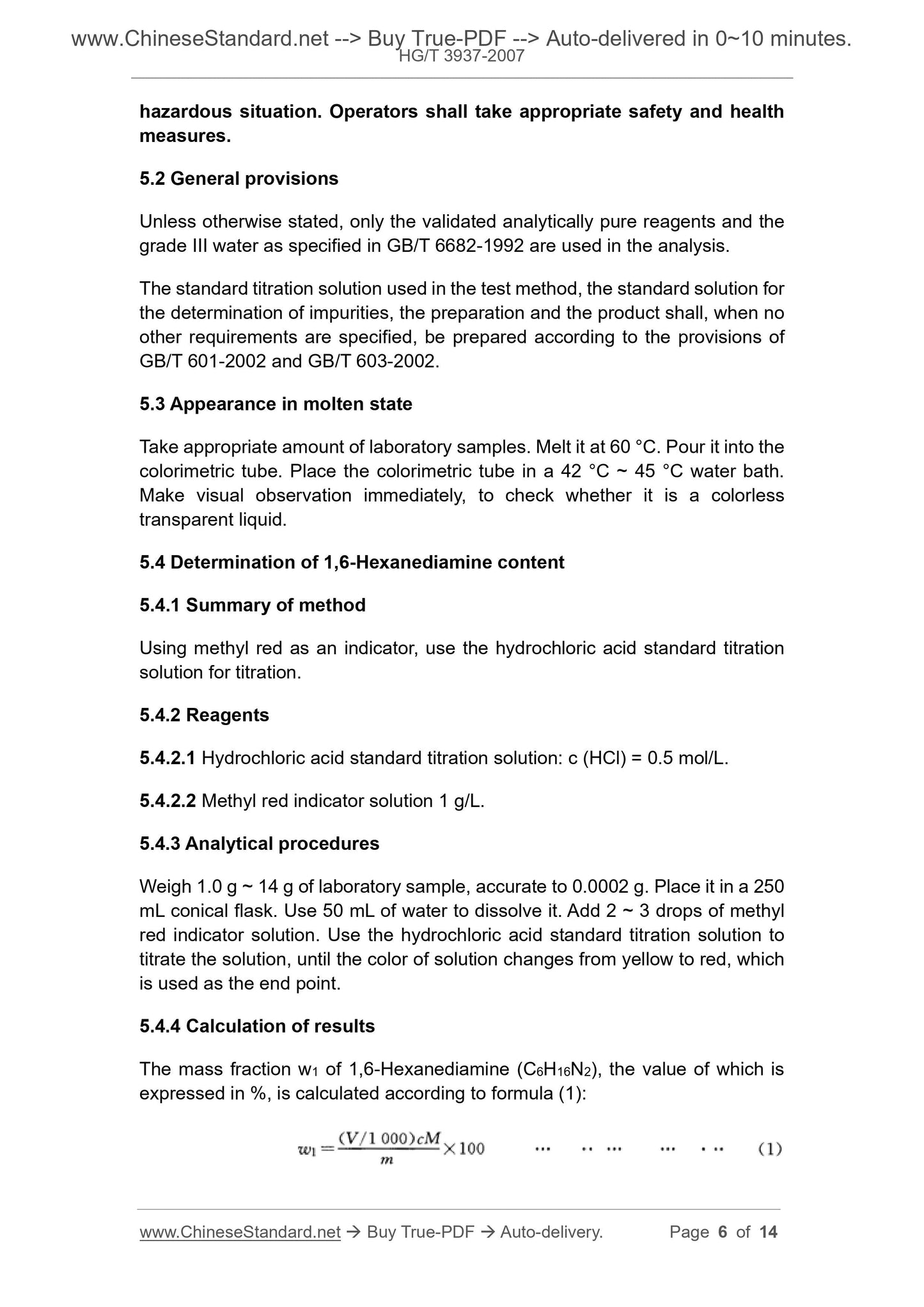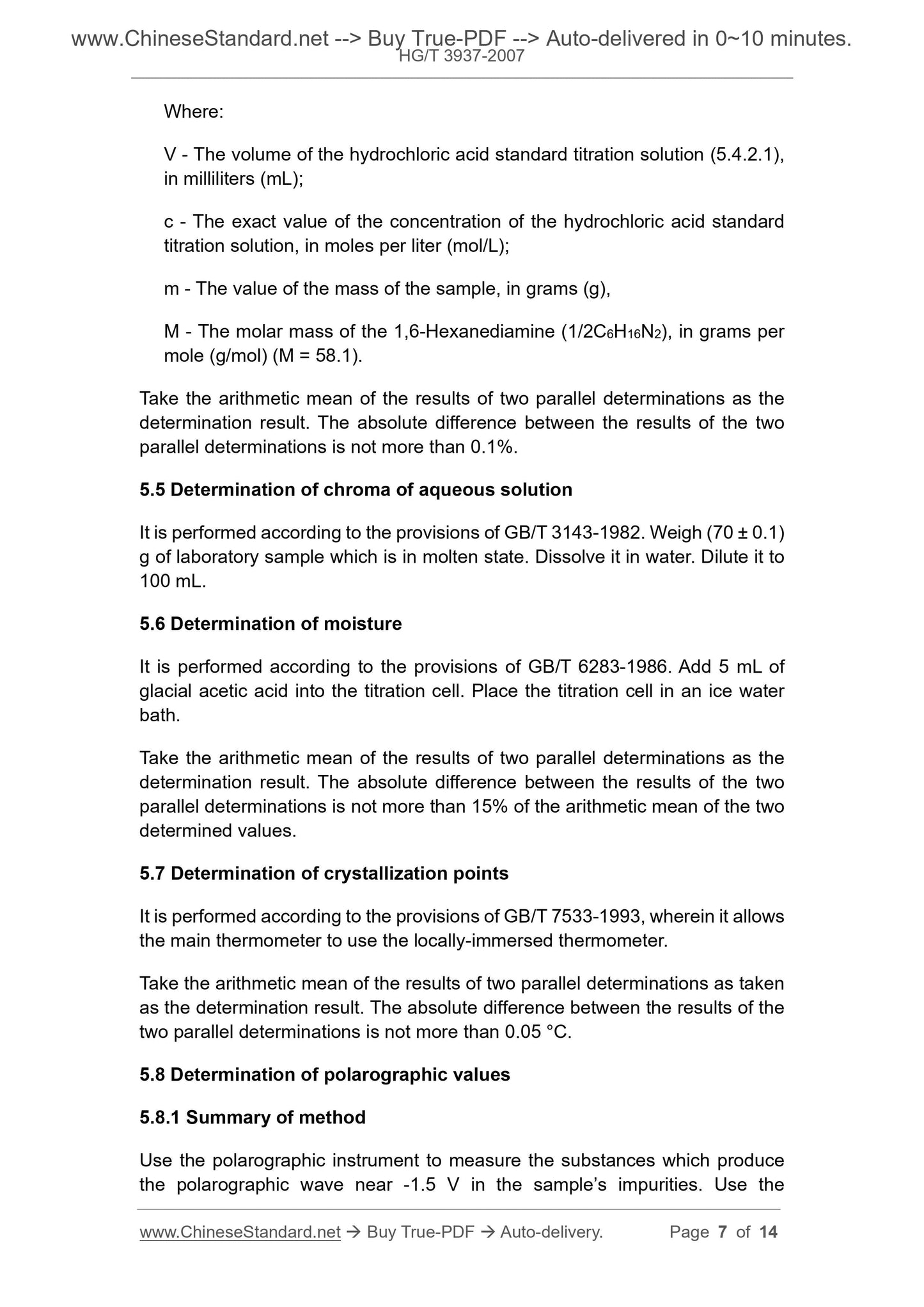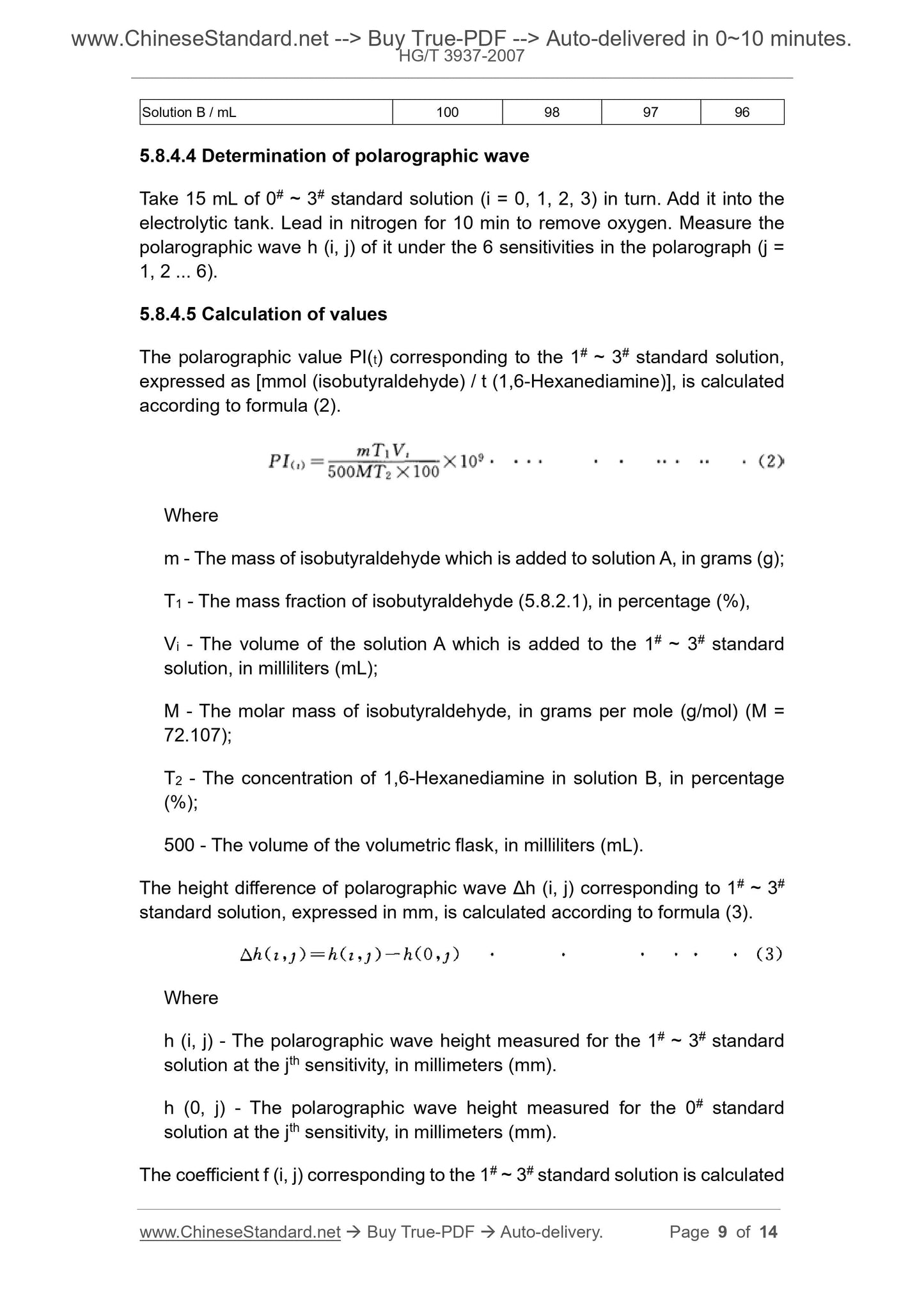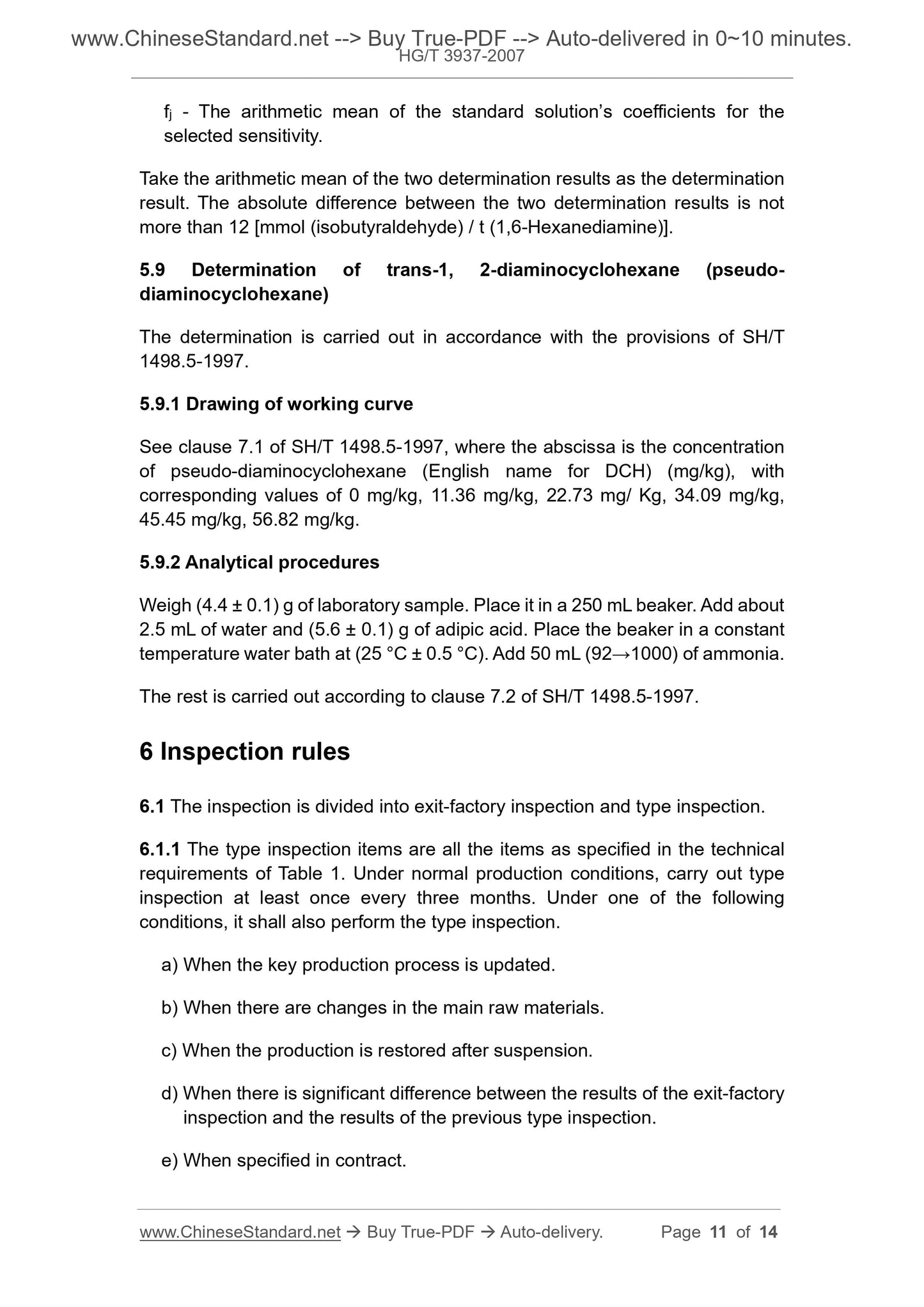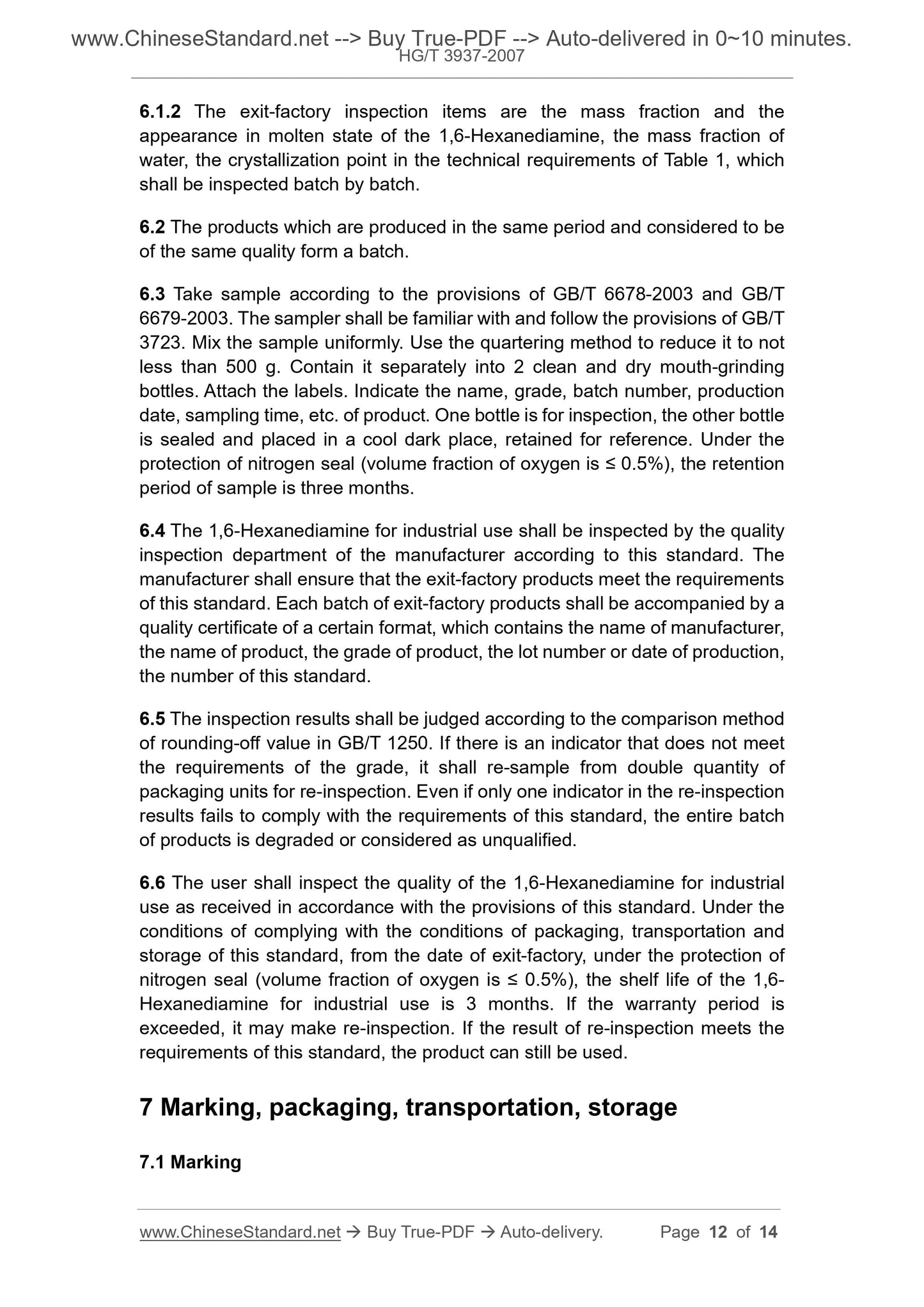1
/
of
8
www.ChineseStandard.us -- Field Test Asia Pte. Ltd.
HG/T 3937-2007 English PDF (HG/T3937-2007)
HG/T 3937-2007 English PDF (HG/T3937-2007)
Regular price
$130.00
Regular price
Sale price
$130.00
Unit price
/
per
Shipping calculated at checkout.
Couldn't load pickup availability
HG/T 3937-2007: 1, 6-Hexanediamine for industrial use
Delivery: 9 seconds. Download (& Email) true-PDF + Invoice.
Get Quotation: Click HG/T 3937-2007 (Self-service in 1-minute)
Historical versions (Master-website): HG/T 3937-2007
Preview True-PDF (Reload/Scroll-down if blank)
HG/T 3937-2007
HG
CHEMICAL INDUSTRY STANDARD OF
THE PEOPLE’S REPUBLIC OF CHINA
ICS 71.080.30
G 17
Registration number. 20519-2007
1,6-Hexanediamine for industrial use
ISSUED ON. APRIL 13, 2007
IMPLEMENTED ON. OCTOBER 01, 2007
Issued by. National Development and Reform Commission
Table of Contents
Foreword ... 3
1 Scope ... 4
2 Normative references ... 4
3 Traits ... 5
4 Requirements ... 5
5 Test methods ... 5
6 Inspection rules ... 11
7 Marking, packaging, transportation, storage ... 12
8 Safety ... 13
1,6-Hexanediamine for industrial use
1 Scope
This standard specifies the requirements, test methods, inspection rules,
marking, packaging, transportation, storage and safety of 1,6-Hexanediamine
for industrial use.
This standard applies to the production, inspection and sale of 1,6-
Hexanediamine for industrial use which is produced by catalytic hydrogenation
of adiponitrile which is used as raw material.
Molecular formula. C6H16N2
Relative molecular mass. 116.21 (according to 2005 international relative
atomic mass)
Structural formula. H2N(CH2)6NH2
2 Normative references
The provisions in following documents become the provisions of this standard
through reference in this standard. For the dated references, the subsequent
amendments (excluding corrections) or revisions do not apply to this standard;
however, parties who reach an agreement based on this standard are
encouraged to study if the latest versions of these documents are applicable.
For undated references, the latest edition of the referenced document applies.
GB 190-1990 Labels for packages of dangerous goods
GB/T 601-2002 Chemical reagent - Preparations of standard volumetric
solutions
GB/T 603-2002 Chemical reagent - Preparations of reagent solution for use
in test methods (neq ISO 6353-1.1982)
GB/T 1250 Methods for representation and determination of limit values
GB/T 3143-1982 Determination of the color of liquid chemistry product
(Hazen unit - platinum-cobalt chroma) (eqv ISO 2211.1973)
GB/T 3723 Sampling of chemical products for industrial use - Safety in
sampling (idt ISO 3165.1976)
hazardous situation. Operators shall take appropriate safety and health
measures.
5.2 General provisions
Unless otherwise stated, only the validated analytically pure reagents and the
grade III water as specified in GB/T 6682-1992 are used in the analysis.
The standard titration solution used in the test method, the standard solution for
the determination of impurities, the preparation and the product shall, when no
other requirements are specified, be prepared according to the provisions of
GB/T 601-2002 and GB/T 603-2002.
5.3 Appearance in molten state
Take appropriate amount of laboratory samples. Melt it at 60 °C. Pour it into the
colorimetric tube. Place the colorimetric tube in a 42 °C ~ 45 °C water bath.
Make visual observation immediately, to check whether it is a colorless
transparent liquid.
5.4 Determination of 1,6-Hexanediamine content
5.4.1 Summary of method
Using methyl red as an indicator, use the hydrochloric acid standard titration
solution for titration.
5.4.2 Reagents
5.4.2.1 Hydrochloric acid standard titration solution. c (HCl) = 0.5 mol/L.
5.4.2.2 Methyl red indicator solution 1 g/L.
5.4.3 Analytical procedures
Weigh 1.0 g ~ 14 g of laboratory sample, accurate to 0.0002 g. Place it in a 250
mL conical flask. Use 50 mL of water to dissolve it. Add 2 ~ 3 drops of methyl
red indicator solution. Use the hydrochloric acid standard titration solution to
titrate the solution, until the color of solution changes from yellow to red, which
is used as the end point.
5.4.4 Calculation of results
The mass fraction w1 of 1,6-Hexanediamine (C6H16N2), the value of which is
expressed in %, is calculated according to formula (1).
Where.
V - The volume of the hydrochloric acid standard titration solution (5.4.2.1),
in milliliters (mL);
c - The exact value of the concentration of the hydrochloric acid standard
titration solution, in moles per liter (mol/L);
m - The value of the mass of the sample, in grams (g),
M - The molar mass of the 1,6-Hexanediamine (1/2C6H16N2), in grams per
mole (g/mol) (M = 58.1).
Take the arithmetic mean of the results of two parallel determinations as the
determination result. The absolute difference between the results of the two
parallel determinations is not more than 0.1%.
5.5 Determination of chroma of aqueous solution
It is performed according to the provisions of GB/T 3143-1982. Weigh (70 ± 0.1)
g of laboratory sample which is in molten state. Dissolve it in water. Dilute it to
100 mL.
5.6 Determination of moisture
It is performed according to the provisions of GB/T 6283-1986. Add 5 mL of
glacial acetic acid into the titration cell. Place the titration cell in an ice water
bath.
Take the arithmetic mean of the results of two parallel determinations as the
determination result. The absolute difference between the results of the two
parallel determinations is not more than 15% of the arithmetic mean of the two
determined values.
5.7 Determination of crystallization points
It is performed according to the provisions of GB/T 7533-1993, wherein it allows
the main thermometer to use the locally-immersed thermometer.
Take the arithmetic mean of the results of two parallel determinations as taken
as the determination result. The absolute difference between the results of the
two parallel determinations is not more than 0.05 °C.
5.8 Determination of polarographic values
5.8.1 Summary of method
Use the polarographic instrument to measure the substances which produce
the polarographic wave near -1.5 V in the sample’s impurities. Use the
Solution B / mL 100 98 97 96
5.8.4.4 Determination of polarographic wave
Take 15 mL of 0# ~ 3# standard solution (i = 0, 1, 2, 3) in turn. Add it into the
electrolytic tank. Lead in nitrogen for 10 min to remove oxygen. Measure the
polarographic wave h (i, j) of it under the 6 sensitivities in the polarograph (j =
1, 2 ... 6).
5.8.4.5 Calculation of values
The polarographic value PI(t) corresponding to the 1# ~ 3# standard solution,
expressed as [mmol (isobutyraldehyde) / t (1,6-Hexanediamine)], is calculated
according to formula (2).
Where
m - The mass of isobutyraldehyde which is added to solution A, in grams (g);
T1 - The mass fraction of isobutyraldehyde (5.8.2.1), in percentage (%),
Vi - The volume of the solution A which is added to the 1# ~ 3# standard
solution, in milliliters (mL);
M - The molar mass of isobutyraldehyde, in grams per mole (g/mol) (M =
72.107);
T2 - The concentration of 1,6-Hexanediamine in solution B, in percentage
(%);
500 - The volume of the volumetric flask, in milliliters (mL).
The height difference of polarographic wave Δh (i, j) corresponding to 1# ~ 3#
standard solution, expressed in mm, is calculated according to formula (3).
Where
h (i, j) - The polarographic wave height measured for the 1# ~ 3# standard
solution at the jth sensitivity, in millimeters (mm).
h (0, j) - The polarographic wave height measured for the 0# standard
solution at the jth sensitivity, in millimeters (mm).
The coefficient f (i, j) corresponding to the 1# ~ 3# standard solution is calculated
fj - The arithmetic mean of the standard solution’s coefficients for the
selected sensitivity.
Take the arithmetic mean of the two determination results as the determination
result. The absolute difference between the two determination results is not
more than 12 [mmol (isobutyraldehyde) / t (1,6-Hexanediamine)].
5.9 Determination of trans-1, 2-diaminocyclohexane (pseudo-
diaminocyclohexane)
The determination is carried out in accordance with the provisions of SH/T
1498.5-1997.
5.9.1 Drawing of working curve
See clause 7.1 of SH/T 1498.5-1997, where the abscissa is the concentration
of pseudo-diaminocyclohexane (English name for DCH) (mg/kg), with
corresponding values of 0 mg/kg, 11.36 mg/kg, 22.73 mg/ Kg, 34.09 mg/kg,
45.45 mg/kg, 56.82 mg/kg.
5.9.2 Analytical procedures
Weigh (4.4 ± 0.1) g of laboratory sample. Place it in a 250 mL beaker. Add about
2.5 mL of water and (5.6 ± 0.1) g of adipic acid. Place the beaker in a constant
temperature water bath at (25 °C ± 0.5 °C). Add 50 mL (92→1000) of ammonia.
The rest is carried out according to clause 7.2 of SH/T 1498.5-1997.
6 Inspection rules
6.1 The inspection is divided into exit-factory inspection and type inspection.
6.1.1 The type inspection items are all the items as specified in the technical
requirements of Table 1. Under normal production conditions, carry out type
inspection at least once every three months. Under one of the following
conditions, it shall also perform the type inspection.
a) When the key production process is updated.
b) When there are changes in the main raw materials.
c) When the production is restored after suspension.
d) When there is significant difference between the results of the exit-factory
inspection and the results of the previous type inspection.
e) When specified in contract.
6.1.2 The exit-factory inspection items are the mass fraction and the
appearance in molten state of the 1,6-Hexanediamine, the mass fraction of
water, the crystallization point in the technical requirements of Table 1, which
shall be inspected batch by batch.
6.2 The products which are produced in the same period and considered to be
of the same quality form a batch.
6.3 Take sample according to the provisions of GB/T 6678-2003 and GB/T
6679-2003. The sampler shall be familiar with and follow the provisions of GB/T
3723. Mix the sample uniformly. Use the quartering method to reduce it to not
less than 500 g. Contain it separately into 2 clean and dry mouth-grinding
bottles. Attach the labels. Indicate the name, grade, batch number, production
date, sampling time, etc. of product. One bottle is for inspection, the other bottle
is sealed and placed in a cool dark place, retained for reference. Under the
protection of nitrogen seal (volume fraction of oxygen is ≤ 0.5%), the retention
period of sample is three months.
6.4 The 1,6-Hexanediamine for industrial use shall be inspected by the quality
inspection department of the manufacturer according to this standard. The
manufacturer shall ensure that the exit-factory products meet the requirements
of this standard. Each batch of exit-factory products shall be accompanied by a
quality certificate of a certain format, which contains the name of manufacturer,
the name of product, the grade of product, the lot number or date of production,
the number of this standard.
6.5 The inspection results shall be judged according to the comparison method
of rounding-off value in GB/T 1250. If there is an indicator that does not meet
the requirements of the grade, it shall re-sample from double quantity of
packaging units for re-inspection. Even if only one indicator in the re-inspection
results fails to comply with the requirements of this standard, the entire batch
of products is degraded or considered as unqualified.
6.6 The user shall inspect the quality of the 1,6-Hexanediamine for industrial
use as received in accordance with the provisions of this standard. Under the
conditions of complying with the conditions of packaging, transportation and
storage of this standard, from the date of exit-factory, under the protection of
nitrogen seal (volume fraction of oxygen is ≤ 0.5%), the shelf life of the 1,6-
Hexanediamine for industrial use is 3 months. If the warranty period is
exceeded, it may make re-inspection. If the result of re-inspection meets the
requirements of this standard, the product can still be used.
7 Marking, packaging, transportation, storage
7.1 Marking
HG/T 3937-2007
HG
CHEMICAL INDUSTRY STANDARD OF
THE PEOPLE’S REPUBLIC OF CHINA
ICS 71.080.30
G 17
Registration number. 20519-2007
1,6-Hexanediamine for industrial use
ISSUED ON. APRIL 13, 2007
IMPLEMENTED ON. OCTOBER 01, 2007
Issued by. National Development and Reform Commission
Table of Contents
Foreword ... 3
1 Scope ... 4
2 Normative references ... 4
3 Traits ... 5
4 Requirements ... 5
5 Test methods ... 5
6 Inspection rules ... 11
7 Marking, packaging, transportation, storage ... 12
8 Safety ... 13
1,6-Hexanediamine for industrial use
1 Scope
This standard specifies the requirements, test methods, inspection rules,
marking, packaging, transportation, storage and safety of 1,6-Hexanediamine
for industrial use.
This standard applies to the production, inspection and sale of 1,6-
Hexanediamine for industrial use which is produced by catalytic hydrogenation
of adiponitrile which is used as raw material.
Molecular formula. C6H16N2
Relative molecular mass. 116.21 (according to 2005 international relative
atomic mass)
Structural formula. H2N(CH2)6NH2
2 Normative references
The provisions in following documents become the provisions of this standard
through reference in this standard. For the dated references, the subsequent
amendments (excluding corrections) or revisions do not apply to this standard;
however, parties who reach an agreement based on this standard are
encouraged to study if the latest versions of these documents are applicable.
For undated references, the latest edition of the referenced document applies.
GB 190-1990 Labels for packages of dangerous goods
GB/T 601-2002 Chemical reagent - Preparations of standard volumetric
solutions
GB/T 603-2002 Chemical reagent - Preparations of reagent solution for use
in test methods (neq ISO 6353-1.1982)
GB/T 1250 Methods for representation and determination of limit values
GB/T 3143-1982 Determination of the color of liquid chemistry product
(Hazen unit - platinum-cobalt chroma) (eqv ISO 2211.1973)
GB/T 3723 Sampling of chemical products for industrial use - Safety in
sampling (idt ISO 3165.1976)
hazardous situation...
Delivery: 9 seconds. Download (& Email) true-PDF + Invoice.
Get Quotation: Click HG/T 3937-2007 (Self-service in 1-minute)
Historical versions (Master-website): HG/T 3937-2007
Preview True-PDF (Reload/Scroll-down if blank)
HG/T 3937-2007
HG
CHEMICAL INDUSTRY STANDARD OF
THE PEOPLE’S REPUBLIC OF CHINA
ICS 71.080.30
G 17
Registration number. 20519-2007
1,6-Hexanediamine for industrial use
ISSUED ON. APRIL 13, 2007
IMPLEMENTED ON. OCTOBER 01, 2007
Issued by. National Development and Reform Commission
Table of Contents
Foreword ... 3
1 Scope ... 4
2 Normative references ... 4
3 Traits ... 5
4 Requirements ... 5
5 Test methods ... 5
6 Inspection rules ... 11
7 Marking, packaging, transportation, storage ... 12
8 Safety ... 13
1,6-Hexanediamine for industrial use
1 Scope
This standard specifies the requirements, test methods, inspection rules,
marking, packaging, transportation, storage and safety of 1,6-Hexanediamine
for industrial use.
This standard applies to the production, inspection and sale of 1,6-
Hexanediamine for industrial use which is produced by catalytic hydrogenation
of adiponitrile which is used as raw material.
Molecular formula. C6H16N2
Relative molecular mass. 116.21 (according to 2005 international relative
atomic mass)
Structural formula. H2N(CH2)6NH2
2 Normative references
The provisions in following documents become the provisions of this standard
through reference in this standard. For the dated references, the subsequent
amendments (excluding corrections) or revisions do not apply to this standard;
however, parties who reach an agreement based on this standard are
encouraged to study if the latest versions of these documents are applicable.
For undated references, the latest edition of the referenced document applies.
GB 190-1990 Labels for packages of dangerous goods
GB/T 601-2002 Chemical reagent - Preparations of standard volumetric
solutions
GB/T 603-2002 Chemical reagent - Preparations of reagent solution for use
in test methods (neq ISO 6353-1.1982)
GB/T 1250 Methods for representation and determination of limit values
GB/T 3143-1982 Determination of the color of liquid chemistry product
(Hazen unit - platinum-cobalt chroma) (eqv ISO 2211.1973)
GB/T 3723 Sampling of chemical products for industrial use - Safety in
sampling (idt ISO 3165.1976)
hazardous situation. Operators shall take appropriate safety and health
measures.
5.2 General provisions
Unless otherwise stated, only the validated analytically pure reagents and the
grade III water as specified in GB/T 6682-1992 are used in the analysis.
The standard titration solution used in the test method, the standard solution for
the determination of impurities, the preparation and the product shall, when no
other requirements are specified, be prepared according to the provisions of
GB/T 601-2002 and GB/T 603-2002.
5.3 Appearance in molten state
Take appropriate amount of laboratory samples. Melt it at 60 °C. Pour it into the
colorimetric tube. Place the colorimetric tube in a 42 °C ~ 45 °C water bath.
Make visual observation immediately, to check whether it is a colorless
transparent liquid.
5.4 Determination of 1,6-Hexanediamine content
5.4.1 Summary of method
Using methyl red as an indicator, use the hydrochloric acid standard titration
solution for titration.
5.4.2 Reagents
5.4.2.1 Hydrochloric acid standard titration solution. c (HCl) = 0.5 mol/L.
5.4.2.2 Methyl red indicator solution 1 g/L.
5.4.3 Analytical procedures
Weigh 1.0 g ~ 14 g of laboratory sample, accurate to 0.0002 g. Place it in a 250
mL conical flask. Use 50 mL of water to dissolve it. Add 2 ~ 3 drops of methyl
red indicator solution. Use the hydrochloric acid standard titration solution to
titrate the solution, until the color of solution changes from yellow to red, which
is used as the end point.
5.4.4 Calculation of results
The mass fraction w1 of 1,6-Hexanediamine (C6H16N2), the value of which is
expressed in %, is calculated according to formula (1).
Where.
V - The volume of the hydrochloric acid standard titration solution (5.4.2.1),
in milliliters (mL);
c - The exact value of the concentration of the hydrochloric acid standard
titration solution, in moles per liter (mol/L);
m - The value of the mass of the sample, in grams (g),
M - The molar mass of the 1,6-Hexanediamine (1/2C6H16N2), in grams per
mole (g/mol) (M = 58.1).
Take the arithmetic mean of the results of two parallel determinations as the
determination result. The absolute difference between the results of the two
parallel determinations is not more than 0.1%.
5.5 Determination of chroma of aqueous solution
It is performed according to the provisions of GB/T 3143-1982. Weigh (70 ± 0.1)
g of laboratory sample which is in molten state. Dissolve it in water. Dilute it to
100 mL.
5.6 Determination of moisture
It is performed according to the provisions of GB/T 6283-1986. Add 5 mL of
glacial acetic acid into the titration cell. Place the titration cell in an ice water
bath.
Take the arithmetic mean of the results of two parallel determinations as the
determination result. The absolute difference between the results of the two
parallel determinations is not more than 15% of the arithmetic mean of the two
determined values.
5.7 Determination of crystallization points
It is performed according to the provisions of GB/T 7533-1993, wherein it allows
the main thermometer to use the locally-immersed thermometer.
Take the arithmetic mean of the results of two parallel determinations as taken
as the determination result. The absolute difference between the results of the
two parallel determinations is not more than 0.05 °C.
5.8 Determination of polarographic values
5.8.1 Summary of method
Use the polarographic instrument to measure the substances which produce
the polarographic wave near -1.5 V in the sample’s impurities. Use the
Solution B / mL 100 98 97 96
5.8.4.4 Determination of polarographic wave
Take 15 mL of 0# ~ 3# standard solution (i = 0, 1, 2, 3) in turn. Add it into the
electrolytic tank. Lead in nitrogen for 10 min to remove oxygen. Measure the
polarographic wave h (i, j) of it under the 6 sensitivities in the polarograph (j =
1, 2 ... 6).
5.8.4.5 Calculation of values
The polarographic value PI(t) corresponding to the 1# ~ 3# standard solution,
expressed as [mmol (isobutyraldehyde) / t (1,6-Hexanediamine)], is calculated
according to formula (2).
Where
m - The mass of isobutyraldehyde which is added to solution A, in grams (g);
T1 - The mass fraction of isobutyraldehyde (5.8.2.1), in percentage (%),
Vi - The volume of the solution A which is added to the 1# ~ 3# standard
solution, in milliliters (mL);
M - The molar mass of isobutyraldehyde, in grams per mole (g/mol) (M =
72.107);
T2 - The concentration of 1,6-Hexanediamine in solution B, in percentage
(%);
500 - The volume of the volumetric flask, in milliliters (mL).
The height difference of polarographic wave Δh (i, j) corresponding to 1# ~ 3#
standard solution, expressed in mm, is calculated according to formula (3).
Where
h (i, j) - The polarographic wave height measured for the 1# ~ 3# standard
solution at the jth sensitivity, in millimeters (mm).
h (0, j) - The polarographic wave height measured for the 0# standard
solution at the jth sensitivity, in millimeters (mm).
The coefficient f (i, j) corresponding to the 1# ~ 3# standard solution is calculated
fj - The arithmetic mean of the standard solution’s coefficients for the
selected sensitivity.
Take the arithmetic mean of the two determination results as the determination
result. The absolute difference between the two determination results is not
more than 12 [mmol (isobutyraldehyde) / t (1,6-Hexanediamine)].
5.9 Determination of trans-1, 2-diaminocyclohexane (pseudo-
diaminocyclohexane)
The determination is carried out in accordance with the provisions of SH/T
1498.5-1997.
5.9.1 Drawing of working curve
See clause 7.1 of SH/T 1498.5-1997, where the abscissa is the concentration
of pseudo-diaminocyclohexane (English name for DCH) (mg/kg), with
corresponding values of 0 mg/kg, 11.36 mg/kg, 22.73 mg/ Kg, 34.09 mg/kg,
45.45 mg/kg, 56.82 mg/kg.
5.9.2 Analytical procedures
Weigh (4.4 ± 0.1) g of laboratory sample. Place it in a 250 mL beaker. Add about
2.5 mL of water and (5.6 ± 0.1) g of adipic acid. Place the beaker in a constant
temperature water bath at (25 °C ± 0.5 °C). Add 50 mL (92→1000) of ammonia.
The rest is carried out according to clause 7.2 of SH/T 1498.5-1997.
6 Inspection rules
6.1 The inspection is divided into exit-factory inspection and type inspection.
6.1.1 The type inspection items are all the items as specified in the technical
requirements of Table 1. Under normal production conditions, carry out type
inspection at least once every three months. Under one of the following
conditions, it shall also perform the type inspection.
a) When the key production process is updated.
b) When there are changes in the main raw materials.
c) When the production is restored after suspension.
d) When there is significant difference between the results of the exit-factory
inspection and the results of the previous type inspection.
e) When specified in contract.
6.1.2 The exit-factory inspection items are the mass fraction and the
appearance in molten state of the 1,6-Hexanediamine, the mass fraction of
water, the crystallization point in the technical requirements of Table 1, which
shall be inspected batch by batch.
6.2 The products which are produced in the same period and considered to be
of the same quality form a batch.
6.3 Take sample according to the provisions of GB/T 6678-2003 and GB/T
6679-2003. The sampler shall be familiar with and follow the provisions of GB/T
3723. Mix the sample uniformly. Use the quartering method to reduce it to not
less than 500 g. Contain it separately into 2 clean and dry mouth-grinding
bottles. Attach the labels. Indicate the name, grade, batch number, production
date, sampling time, etc. of product. One bottle is for inspection, the other bottle
is sealed and placed in a cool dark place, retained for reference. Under the
protection of nitrogen seal (volume fraction of oxygen is ≤ 0.5%), the retention
period of sample is three months.
6.4 The 1,6-Hexanediamine for industrial use shall be inspected by the quality
inspection department of the manufacturer according to this standard. The
manufacturer shall ensure that the exit-factory products meet the requirements
of this standard. Each batch of exit-factory products shall be accompanied by a
quality certificate of a certain format, which contains the name of manufacturer,
the name of product, the grade of product, the lot number or date of production,
the number of this standard.
6.5 The inspection results shall be judged according to the comparison method
of rounding-off value in GB/T 1250. If there is an indicator that does not meet
the requirements of the grade, it shall re-sample from double quantity of
packaging units for re-inspection. Even if only one indicator in the re-inspection
results fails to comply with the requirements of this standard, the entire batch
of products is degraded or considered as unqualified.
6.6 The user shall inspect the quality of the 1,6-Hexanediamine for industrial
use as received in accordance with the provisions of this standard. Under the
conditions of complying with the conditions of packaging, transportation and
storage of this standard, from the date of exit-factory, under the protection of
nitrogen seal (volume fraction of oxygen is ≤ 0.5%), the shelf life of the 1,6-
Hexanediamine for industrial use is 3 months. If the warranty period is
exceeded, it may make re-inspection. If the result of re-inspection meets the
requirements of this standard, the product can still be used.
7 Marking, packaging, transportation, storage
7.1 Marking
HG/T 3937-2007
HG
CHEMICAL INDUSTRY STANDARD OF
THE PEOPLE’S REPUBLIC OF CHINA
ICS 71.080.30
G 17
Registration number. 20519-2007
1,6-Hexanediamine for industrial use
ISSUED ON. APRIL 13, 2007
IMPLEMENTED ON. OCTOBER 01, 2007
Issued by. National Development and Reform Commission
Table of Contents
Foreword ... 3
1 Scope ... 4
2 Normative references ... 4
3 Traits ... 5
4 Requirements ... 5
5 Test methods ... 5
6 Inspection rules ... 11
7 Marking, packaging, transportation, storage ... 12
8 Safety ... 13
1,6-Hexanediamine for industrial use
1 Scope
This standard specifies the requirements, test methods, inspection rules,
marking, packaging, transportation, storage and safety of 1,6-Hexanediamine
for industrial use.
This standard applies to the production, inspection and sale of 1,6-
Hexanediamine for industrial use which is produced by catalytic hydrogenation
of adiponitrile which is used as raw material.
Molecular formula. C6H16N2
Relative molecular mass. 116.21 (according to 2005 international relative
atomic mass)
Structural formula. H2N(CH2)6NH2
2 Normative references
The provisions in following documents become the provisions of this standard
through reference in this standard. For the dated references, the subsequent
amendments (excluding corrections) or revisions do not apply to this standard;
however, parties who reach an agreement based on this standard are
encouraged to study if the latest versions of these documents are applicable.
For undated references, the latest edition of the referenced document applies.
GB 190-1990 Labels for packages of dangerous goods
GB/T 601-2002 Chemical reagent - Preparations of standard volumetric
solutions
GB/T 603-2002 Chemical reagent - Preparations of reagent solution for use
in test methods (neq ISO 6353-1.1982)
GB/T 1250 Methods for representation and determination of limit values
GB/T 3143-1982 Determination of the color of liquid chemistry product
(Hazen unit - platinum-cobalt chroma) (eqv ISO 2211.1973)
GB/T 3723 Sampling of chemical products for industrial use - Safety in
sampling (idt ISO 3165.1976)
hazardous situation...
Share
